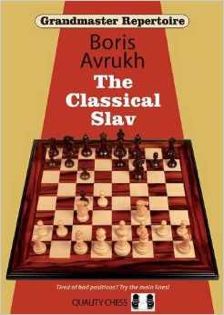Classical Slav, The
Boris Avrukh

Israeli Grandmaster Boris Avrukh is the author of acclaimed repertoire books on 1.d4 and the Grunfeld, but his latest book, THE CLASSICAL SLAV, may be his best yet offering the reader a complete repertoire that provides aggressive but solid play.
This book covers all of Whites tries after 1.d4 d5 2.c4 c6 as follows:
Rare Lines
1 3.e3 and 4.Bd3 7
2 3.Bf4 13
3 4.Bf4 and 4.Bg5 17
Exchange Variation
4 Minor Lines 23
5 Old Main Lines 33
6 7.Qb3 47
3.Nc3 Nf6 4.e3 a6
7 Introduction 55
8 5.Qc2 69
9 6.cxd5, 6.Nh4 and 6.Ne5 88
10 6.Bd2, 6.Be2 and 6.Bd3 101
11 6.Qb3 114
3.Nc3 Nf6 4.e3 Bf5
12 Introduction and 5.Bd3 132
13 5.Qb3 142
14 5.cxd5 Glasgow Kiss 154
4th Move Alternatives
15 3.Nf3 Nf6 4.e3 Bf5 175
16 4.e3 Bf5 5.cxd5 183
17 4.g3 197
18 4.Nbd2 211
19 4.Qc2 and 4.Qb3 Sidelines 220
20 5.Qxc4 Main Line 240
4…dxc4
21 5.g3 and 5.e3 254
22 5.e4 Geller Gambit 264
23 5.a4 273
24 6.Nh4 e6 283
6.e3
25 Introduction 289
26 9.Nh4 299
27 9.Qe2 313
28 10.e4 319
29 15.Ng5 336
6.Ne5
30 6…Nbd7 7.Nxc4 Qc7 351
31 8.g3 360
32 11…f6 369
33 Morozevich 12.Nxe5 and 12.Bxe5 381
34 Morozevich 12.Ne3 396
Avrukh offers one response to each White setup with two exceptions. Against 1.d4 d5 2.c4 c6 3.Nc3 Nf6 4.e3 he gives both 4…Bf5 and 4…a6. The former use to be considered inferior on account of 5.cxd5 cxd5 6.Qb3 but after 6…Nc6, the start of the so-called “Glasgow Kiss variation, play becomes very sharp with Black having excellent compensation for the pawn. Avrukh analyzes this variation quite thoroughly, going more than 20 moves deep in some critical lines, and comes to the conclusion that the line is fully playable. This said, not all Slav players will find this type of play to their liking and accordingly Avrukh offers 4…a6 as an alternative.
Likewise in the most theoretical line of the Slav 1.d4 d5 2.c4 c6 3.Nf3 Nf6 4.Nc3 dxc4 5.a4 Bf5 6.Ne5 the Israeli GM offers two different setups. After 6…Nbd7 7.Nxc4 Qc7 8.g3 e5 9.dxe5 Nxe5 10.Bf4 Nfd7 11.Bg2 the trendy 11…g5 holds up well but is very heavy analyzed so Avrukh also offers the lesser known but promising 11…f6 12.0-0 g5.
Certain lines of the Slav are known for their potentially drawish possibilities and The Classical Slav addresses this issue head on. All players who answer 1.d4 d5 2.c4 with 2…c6 have to consider the possibility that White will play 3.cxd5. Unlike its cousin in the French this Exchange Variation has sting and it is Avrukhs opinion that Black should first aim to equalize and only later try to play for an advantage. This means no early …Qb6, …Nh5 or …a6. He advocates playing …Bf5 and makes a convincing case that if Black knows theory he has nothing to worry about, even in the testing line 4.Nc3 Nf6 5.Bf4 Nc6 6.e3 Bf5 7.Qb3 Na5 8.Qa4+.
While the Exchange Slav poses some philosophical problems (read Black has to be prepared to play a long hard game) a different problem arises after 1.d4 d5 2.c4 c6 3.Nf3 Nf6 4.Nc3 dxc4 5.a4 Bf5 6.e3 e6 7.Bxc4 Bb4 8.0-0. Black now must choose between 8…0-0 and 8…Nbd7. Both lines can and often do transpose if White plays Qe2 and e4 but have different strengths and weakness against 9.Qb3 and 9.Nh4. White has never achieved much after 8…0-0 9.Qb3 Qe7 but 8…0-0 9.Nh4 is a different story. Avrukh opts for 8…Nbd7 which allows Black to preserve the option of …0-0-0 in certain critical lines after 9.Nh4. The price Black plays for this move order is that after 8…Nbd7 9.Qb3 a5 10.Na2 Be7 White can force a draw with 11.Qxb7 Rb8 12.Qa6 Ra8 13.Qxc6 Rc8 14.Qb5 Rb8 15.Qa6 Ra8. For those who find this a problem Avrukh suggests the little played 10…Bd6 which offers Black interesting compensation after 11.Qxb7 Rb8 12.Qa6 0-0.
The Classical Slav is a first rate opening repertoire book that should prove useful for a wide range of players from 1800 on up.
Highly Recommended
